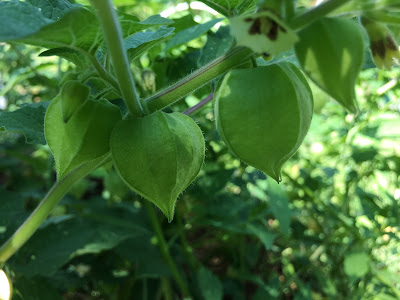 |
| Ground Cherries |
What on earth is a ground cherry? Physalis is an interesting member of the tomato or nightshade family. A number of varieties are native to the United States and we have seen one small variety growing on St. George Island.
Ground cherries are similar to tomatillos, but smaller and sweeter. They grow with the characteristic papery husk like tomatillos and are eaten after they ripen completely and fall to the ground—hence their name—ground cherries. Deliciously sweet tart, they can be eaten raw or used as a fruit for sauces, jams, pies, etc. The husk is not edible.
Cultivated varieties grow well in our area with the same care as tomatoes and subject to the same pests and diseases. We grow them in the VegHeadz garden and seeds for several varieties are available from seed companies online.
Master Gardener Peggy McDonald prefers the variety called Aunt Molly’s and saves the tiny seeds to plant and to share with others. If you’ve grown ground cherries and would like to save the seeds, this is Peggy’s technique.
“Collect ripe cherries from the ground. The papery husk should be a pale tan color.
To process seeds, cut open fully ripe yellow Aunt Molly's ground cherries. Smear on paper towels and let dry several hours.
Then I loosen them with my finger nails into a fine mesh sieve. Rinse and rub under running water for 30 seconds to remove the sticky fruit residue. Turn out onto a clean paper towel, dry several hours.
Pour seeds onto a plate and dry completely for at least two weeks inside in the air conditioning.
Package into paper or plastic envelopes. Label with name and date. The seeds keep for several years. I planted 4 year old seeds and got very good germination in March.
Sprout the seeds and grow under lights when you start your tomatoes and peppers about eight weeks before your last frost.”
Package into paper or plastic envelopes. Label with name and date. The seeds keep for several years. I planted 4 year old seeds and got very good germination in March.
Sprout the seeds and grow under lights when you start your tomatoes and peppers about eight weeks before your last frost.”
Addendum: We received the following inquiry from a reader: My bushes got massive, but almost all of the husks had a pinhole. When I peeled the husk the fruit was either gone or rotten. What did this, do you know?
Peggy’s response: It may be the Ground Cherry Sun Moth, Heliothis subflexa. They chew a small hole in the husk and devour the fruit. All that is left is an empty shell or rotting fruit. Try using an organic spray with BT, bacillus thuringiensis. It is safe for fruit if used properly. Spray several times to break the insect life cycle.
For more information about growing ground cherries, see Growing Ground Cherries.


No comments:
Post a Comment